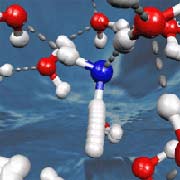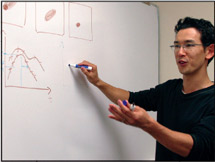

Thursday - March 30, 2006
SLAC Today is
available online at:
http://today.slac.stanford.edu
In this issue:
The Fastest Reaction in Water
Science Today: KIPAC - The Search for Cosmic Supernova Explosions
Safety Update: Keeping Keeping LCLS Construction Safe
 |
 |
|
Thursday - March 30, 2006 |

A representation of the core-hole dissociation process.
The Fastest Reaction in WaterA collaboration including SSRL's Anders Nilsson, Dennis Nordlund and Hirohito Ogasawara has used high-intensity synchrotron x-rays to observe the fastest reaction ever before seen in water—a reaction that takes a mere 3.6 femtoseconds. This reaction is the first step of what happens when ionizing radiation meets water. The interaction starts when x-rays force an electron out of the core, or innermost, orbital around the oxygen atom's nucleus. This leaves a hole in the core, which lasts only 3.6 femtoseconds before it is filled by another electron. The rearrangement of the water molecule's electrons during the core hole's brief lifetime results in one of the hydrogen atoms migrating away from the oxygen. Once dissociated, the molecular fragments can perpetrate chemical reactions and cause serious damage in biological tissues and other materials. Read more... |
||||||||||||||||||||||||||
|
|
||||||||||||||||||||||||||
 KIPAC: The Search for Cosmic Supernova Explosions
Masao Sako explains supernovae. Photo courtesy of Diana Rogers. Several members of the Kavli Institute for Particle Astrophysics and Cosmology (KIPAC)—Masao Sako, Roger Romani, Chen Zheng, Roger Blandford and Steve Kahn—have recently joined the Sloan Digital Sky Survey II (SDSS-II) collaboration to participate in a massive search for supernova explosions from the distant universe. The survey uses the SDSS 2.5-meter telescope at Apache Point Observatory in New Mexico to obtain repeated multi-color images of the same 300 square-degree patch of the sky approximately every other night. A unique large-format CCD camera array with a total of 120 million pixels is capable of recording 200 gigabytes of imaging data in a single night of observing, allowing efficient discoveries of supernova explosions out to redshift z~0.4, or about one-third of the way back to the big bang. Read more... |
Safety Update: Keeping LCLS Construction Safe
Although we encourage interest in LCLS construction, we need to ask employees to refrain from distracting the construction workers. The workers are courteous and would like to respond, however this type of interaction can lead to dangerous situations and lapses in safety. Unless there is an eminent safety concern, all questions should be relayed to the LCLS Project University Technical Representative (UTR) or LCLS Project Manager, instead of the construction workers. The UTR and Project Manager varies from site to site; specific names can be found posted at each construction site. The LCLS Project is exciting and there has been a great deal of positive dialogue regarding the upcoming construction activities. Let’s keep it this way! We want everyone to enjoy the benefits from the facilities currently under construction. |
Events (see all | submit)
Announcements
|
||||||||||||||||||||||||
| | ||||||||||||||||||||||||||
What's Cookin' at the Linear Cafe (see weekly menu)
|
||||||||||||||||||||||||||
|
|
||||||||||||||||||||||||||
 <%
Response.AddHeader "Last-modified", getArticleDate()
'Response.AddHeader "Last-modified","Mon, 01 Sep 1997 01:03:33 GMT"
'Monday, December 06, 2010
%>
<%
Response.AddHeader "Last-modified", getArticleDate()
'Response.AddHeader "Last-modified","Mon, 01 Sep 1997 01:03:33 GMT"
'Monday, December 06, 2010
%>View online at http://today.slac.stanford.edu/. |
||||||||||||||||||||||||||